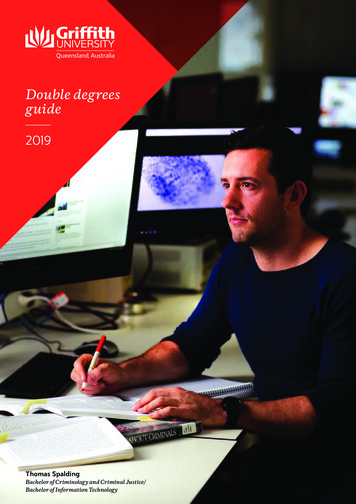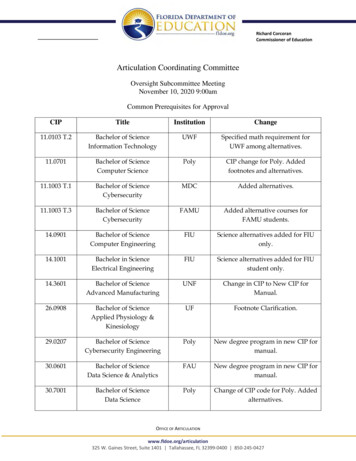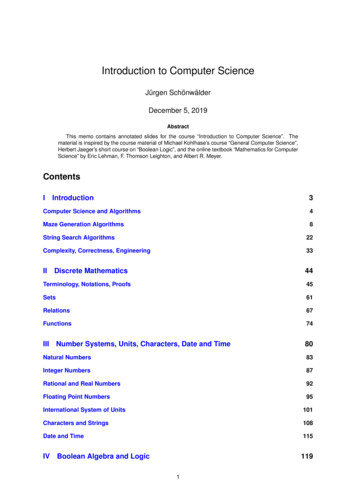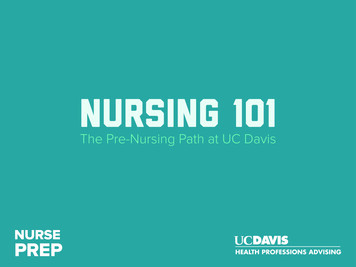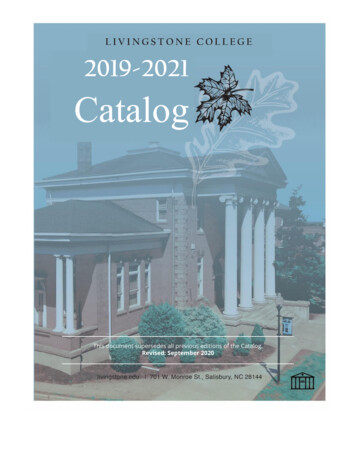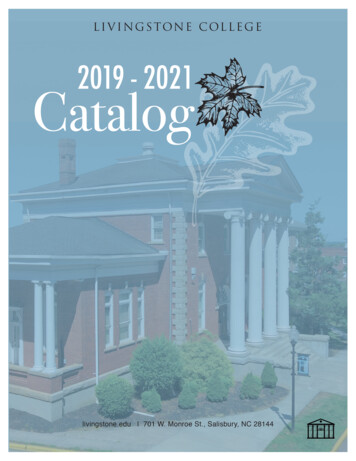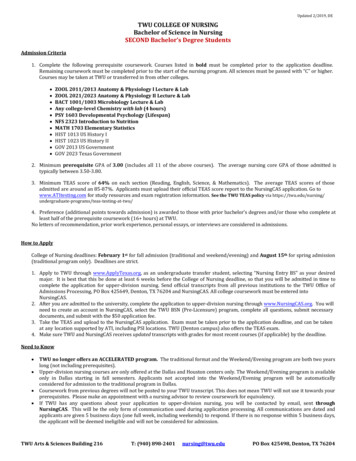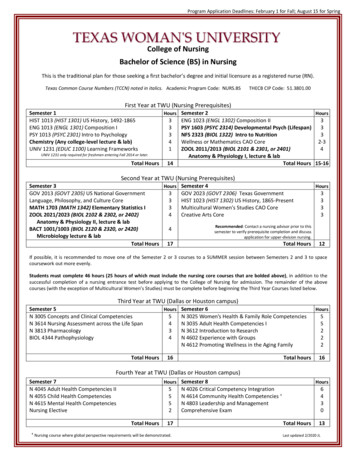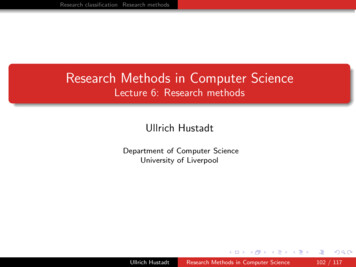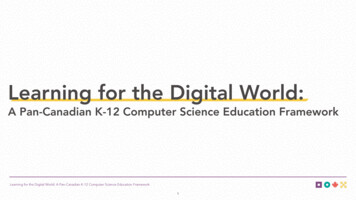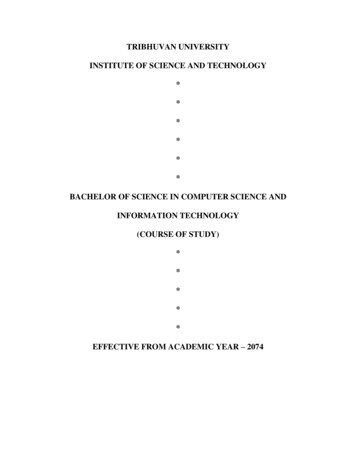
Transcription
TRIBHUVAN UNIVERSITYINSTITUTE OF SCIENCE AND TECHNOLOGY******BACHELOR OF SCIENCE IN COMPUTER SCIENCE ANDINFORMATION TECHNOLOGY(COURSE OF STUDY)*****EFFECTIVE FROM ACADEMIC YEAR – 2074
Tribhuvan UniversityInstitute of Science and TechnologyCourse of StudyBachelor of Science in Computer Science andInformation Technology(B.Sc. CSIT)2017Prepared byComputer Science and Information Technology Subject Committee
Introduction:The Bachelor of Science in Computer Science and Information Technology (B.Sc.CSIT)curriculum is designed by closely following the courses practiced in accredited internationaluniversities, subject to the condition that the intake students are twelve years of schooling in thescience stream or equivalent from any university recognized by Tribhuvan University (TU). Inaddition to the foundation and core Computer Science and Information Technology courses, theprogram offers several elective courses to fulfill the demand of high technology applicationsdevelopment. The foundation and core courses are designed to meet the undergraduate academicprogram requirement, and the service courses are designed to meet the need of fast changingcomputer technology and application. Students enrolled in the four year B.Sc.CSIT program arerequired to take courses in design and implementation of computer software systems, foundationin the theoretical model of computer science, and a functional background of computerhardware. All undergraduate students are required to complete 126 credit hours of computerscience course and allied courses.Objective:The main objective of B.Sc.CSIT program is to provide students intensive knowledge and skillon different areas of computer science and information technology including design, theory,programming and application of computer system. It is envisaged that graduate of this programwill be equipped with necessary knowledge of computer software and hardware system.Eligibility Criteria for AdmissionA student who seeks admission to B.Sc.CSIT program: Should have successfully completed twelve years of schooling in the science stream orequivalent form any university, board or institution. Should have secured a minimum of second division. Should have successfully passed the entrance examination conducted by Institute of Scienceand Technology (IOST), TU. Complied with all the application procedures.Course Duration:The entire course is of eight semesters (four academic years). There is a separate semesterexamination after the end of each semester.i
Hours of Instruction:a) 1Working days: 90 days in a semesterb) Class hours: 3 credit hour courses with theory and lab is equivalent to 3 hours theory and 3 hours lab 6 working hours per week. 3 credit hours theory-only course is equivalent 3 hours theory and 2 hours tutorial 5working hours per week.EvaluationTheory course should have internal weightage of 20% and external weightage of 80%. For thecourse having lab work, the internal weightage is 20%, lab work weightage is 20% and externalweightage is 60%. A student should secure minimum of 40% in each category to pass a course.The final score in each course will be the sum of overall weightage of in all categories. Therewill be a separate practical examination for the 20% weightage of lab work conducted byconcerned college in the presence of an external examiner.The project work and internship are evaluated by different evaluators. To pass project work andinternship, students should secure at least 40% marks in the evaluation of each evaluator andfinal score will be the sum of all the evaluations. For the evaluation of final presentation, anexternal examiner will be assigned from the IOST.The Grading SystemA student having passed his/her 8 semesters (4 years) of study will be graded as follows Distinction: 80 % and above ( 8 semester’s average) First Division: 70 % and above ( 8 semester’s average) Second Division: 55 % and above ( 8 semester’s average) Pass Division: 40 % and above ( 8 semester’s average)Attendance Requirement:Students are required to attend regularly all theory and practical classes and should maintain 80percent attendance in each course separately.ii
Final Examination:Institute of science and technology, Tribhuvan University, will conduct the final examination atthe end of each semester. 80% weightage will be given to the final examination for theory courseand 60% will be given for the course having both theory and practical.Course Structure:Semester ICourse CodeCourse TitleCredit HoursFull MarksCSC109Introduction to Information Technology3100CSC110C Programming3100CSC111Digital Logic3100MTH112Mathematics I3100PHY113Physics310015500TotalSemester IICourse CodeCourse TitleCredit HoursFull MarksCSC160Discrete Structure3100CSC161Object Oriented matics II3100STA164Statistics I310015500TotalSemester IIICourse CodeCourse TitleCredit HoursFull MarksCSC206Data Structure and Algorithms3100CSC207Numerical Method3100CSC208Computer Architecture3100CSC209Computer Graphics3100STA210Statistics II310015500Totaliii
Semester IVCourse CodeCourse TitleCredit HoursFull MarksCSC257Theory of Computation3100CSC258Computer Networks3100CSC259Operating Systems3100CSC260Database Management System3100CSC261Artificial Intelligence310015500TotalSemester VCourse CodeCourse TitleCredit HoursFull MarksCSC314Design and Analysis of Algorithms3100CSC315System Analysis and Design3100CSC316Cryptography3100CSC317Simulation and Modeling3100CSC318Web Technology3100Elective I310018600TotalList of Electives:1. Multimedia Computing (CSC319)2. Wireless Networking (CSC320)3. Image Processing (CSC321)4. Knowledge Management (CSC322)5. Society and Ethics in Information Technology (CSC323)6. Microprocessor Based Design (CSC324)iv
Semester VICourse CodeCourse TitleCredit HoursFull MarksCSC364Software Engineering3100CSC365Complier Design and Construction3100CSC366E-Governance3100CSC367NET Centric Computing3100CSC368Technical Writing3100Elective II310018600TotalList of Electives:1. Applied Logic (CSC369)2. E-commerce (CSC370)3. Automation and Robotics (CSC371)4. Neural Networks (CSC372)5. Computer Hardware Design (CSC373)6. Cognitive Science (CSC374)Semester VIICourse CodeCourse TitleCredit HoursFull MarksCSC409Advanced Java Programming3100CSC410Data Warehousing and Data Mining3100MGT411Principles of Management3100CSC412Project Work3100Elective III310015500TotalList of Electives:1. Information Retrieval (CSC413)2. Database Administration (CSC414)3. Software Project Management (CSC415)4. Network Security (CSC416)5. Digital System Design (CSC417)6. International Marketing (MGT418)v
Semester VIIICourse CodeCourse TitleCredit HoursFull MarksCSC461Advanced Database3100CSC462Internship6200Elective IV3100Elective V310015500TotalList of Electives:1. Advanced Networking with IPV6 (CSC463)2. Distributed Networking (CSC464)3. Game Technology (CSC465)4. Distributed and Object Oriented Database (CSC466)5. Introduction to Cloud Computing (CSC467)6. Geographical Information System (CSC468)7. Decision Support System and Expert System (CSC469)8. Mobile Application Development (CSC470)9. Real Time Systems (CSC471)10. Network and System Administration (CSC472)11. Embedded Systems Programming (CSC473)12. International Business Management (MGT474)vi
Introduction to Information TechnologyCourse Title: Introduction to Information TechnologyCourse No: CSC109Nature of the Course: Theory LabSemester: IFull Marks: 60 20 20Pass Marks: 24 8 8Credit Hrs: 3Course Description: This course covers the basic concepts of computers and informationtechnology including introduction, hardware, software, memory, input/output, datarepresentation, database, networks and data communication, Internet, multimedia, and computersecurity.Course Objectives: The main objective of this course is to provide students knowledge offundamental concepts of computers and information technology.Course Contents:Unit 1: Introduction to Computer (3 Hrs.)Introduction; Digital and Analog Computers; Characteristics of Computer; History of Computer;Generations of Computer; Classification of Computer; The Computer System; Application ofComputersUnit 2: The Computer System Hardware (3 Hrs.)Introduction; Central Processing Unit; Memory Unit; Instruction Format; Instruction Set;Instruction Cycle; Microprocessor; Interconnecting the Units of a Computer; Inside a ComputerCabinetUnit 3: Computer Memory (4 Hrs.)Introduction; Memory Representation; Memory Hierarchy; CPU Registers; Cache Memory;Primary Memory; Secondary Memory; Access Types of Storage Devices; Magnetic Tape;Magnetic Disk; Optical Disk; Magneto-Optical Disk; How the Computer uses its memoryUnit 4: Input and Output Devices (4 Hrs.)Introduction; Input-Output Unit; Input Devices; Human Data Entry Devices; Source Data EntryDevices; Output Devices; I/O Port; Working of I/O SystemUnit 5: Data Representation (6 Hrs.)Introduction; Number System; Conversion from Decimal to Binary, Octal, Hexadecimal;Conversion of Binary, Octal, Hexadecimal to Decimal; Conversion of Binary to Octal,Hexadecimal; Conversion of Octal, Hexadecimal to Binary; Binary Arithmetic; Signed andUnsigned Numbers; Binary Data Representation; Binary Coding Schemes; Logic GatesUnit 6: Computer Software (6 Hrs.)Introduction; Types of Software; System Software; Application Software; Software Acquisition;Operating System (Introduction, Objectives of Operating System, Types of OS, Functions of OS,Process Management, Memory Management, File Management, Device Management, Protectionand Security, User Interface, Examples of Operating Systems)1
Unit 7: Data Communication and Computer Network (5 Hrs.)Introduction; Importance of Networking; Data Transmission Media; Data Transmission acrossMedia; Data Transmission and Data Networking; Computer Network; Network Types; NetworkTopology; Communication Protocol; Network Devices; Wireless NetworkingUnit 8: The Internet and Internet Services (4 Hrs.)Introduction; History of Internet; Internetworking Protocol; The Internet Architecture;Managing the Internet; Connecting to Internet; Internet Connections; Internet Address; InternetServices; Uses of Internet; Introduction to Internet of Things (IoT), Wearable Computing, andCloud Computing, Introduction to E-commerce, E-governance, and Smart City, and GISUnit 9: Fundamentals of Database (4 Hrs.)Introduction; Database; Database System; Database Management System; Database SystemArchitectures; Database Applications; Introduction to Data Warehousing, Data mining, andBigDataUnit 10: Multimedia (3 Hrs.)Introduction; Multimedia - Definition; Characteristics of Multimedia; Elements of Multimedia;Multimedia ApplicationsUnit 11: Computer Security (3 Hrs.)Introduction; Security Threat and Security Attack; Malicious Software; Security Services;Security Mechanisms (Cryptography, Digital Signature, Firewall, Users Identification andAuthentication, Intrusion Detection Systems); Security Awareness; Security PolicyLaboratory Works:After completing this course, students should have practical knowledge of different hardwarecomponents of computer, operating systems, Word Processors, Spreadsheets, PresentationGraphics, Database Management Systems, and Internet and its services.Text Books:1. Computer Fundamentals, Anita Goel, Pearson Education IndiaReference Books:1. Introduction to Computers, Peter Norton, 7th Edition, McGraw Hill Education2. Computer Fundamental, Pradeep K. Sinha and Priti Sinha3. Data Mining Concepts and Techniques, Third Edition, Jiawei Han, Micheline Kamber andJian Pei4. Cloud Computing Bible, Barrie Sosinsky, Wiley2
C ProgrammingCourse Title: C ProgrammingCourse No: CSC110Nature of the course: Theory LabSemester: IFull Marks: 60 20 20Pass Marks: 24 8 8Credit Hrs.: 3Course Description: This course covers the concepts of structured programming using Cprogramming language.Course Objective: This course is designed to familiarize students to the techniques ofprogramming in C.Course Contents:Unit 1: Problem Solving with Computer (2 Hrs.)Problem analysis, Algorithms and Flowchart, Coding, Compilation and Execution, History of C,Structure of C program, Debugging, Testing and DocumentationUnit 2: Elements of C (4 Hrs.)C Standards( ANSI C and C99), C Character Set, C Tokens, Escape sequence, Delimiters,Variables, Data types (Basic, Derived, and User Defined), Structure of a C program, Executing aC program, Constants/ Literals, Expressions, Statements and Comments.Unit 3: Input and Output (2 Hrs.)Conversion specification, Reading a character, Writing a character, I/O operations, FormattedI/OUnit 4: Operators and Expression (4 Hrs.)Arithmetic operator, Relational operator, Logical or Boolean operator, Assignment Operator,Ternary operator, Bitwise operator, Increment or Decrement operator, Conditional operator,Special Operators(sizeof and comma), Evaluation of Expression, Operator Precedence andAssociativity.Unit 5: Control Statement (4 Hrs.)Conditional Statements, Decision Making and Branching, Decision Making and Looping, Exitfunction, Break and Continue.Unit 6: Arrays (6 Hrs.)Introduction to Array, Types of Array (Single Dimensional and Multidimensional), Declarationand Memory Representation of Array, Initialization of array, Character Array and Strings,Reading and Writing Strings, Null Character, String Library Functions( string length, stringcopy, string concatenation, string compare)Unit 7: Functions (5 Hrs.)Library Functions, User defined functions, Funciton prototype, Function call, and FunctionDefinition, Nested and Recursive Function, Function Arguments and Return Types, Passing3
Arrays to Function, Passing Strings to Function, Passing Arguments by Value, PassingArguments by Address, Scope visibility and lifetime of a variable, Local and Global Variable,Unit 8: Structure and Union (5 Hrs.)Introduction, Array of structure, Passing structure to function, Passing array of structure tofunction, Structure within structure ( Nested Structure), Union, Pointer to structureUnit 9: Pointers (6 Hrs.)Introduction, The & and * operator, Declaration of pointer, Chain of Pointers, PointerArithmetic, Pointers and Arrays, Pointers and Character Strings, Array of Pointers, Pointers asFunction Arguments, Function Returning pointers, Pointers and Structures, Dynamic MemoryAllocationUnit 10: File Handling in C (4 Hrs.)Concept of File, Opening and closing of File, Input Output Operations in File, Random access inFile, Error Handling in FilesUnit 11: Introduction to Graphics (3 Hrs.)Concepts of Graphics, Graphics Initialization and Modes, Graphics FunctionLaboratory Works:This course requires a lot of programming practices. Each topic must be followed by a practicalsession. Some practical sessions include programming to: Create, compile and run simple C programs, handle different data types available in C,perform arithmetic operations in C, perform formatted input and output operations,perform character input and output operations.Perform logical operations, create decision making programs, create loops to repeat task.Create user-defined functions, create recursive functions, work with automatic, globaland static variables, create, manipulate arrays and matrices (single and multidimensional), work with pointes, dynamically allocate de-allocate storage space duringruntime, manipulate strings (character arrays) using various string handling functions.Create and use structures and files to keep record of students, employees etc.Text Books:1. Byron Gottfried: "Programming with C," , Second Edition, McGraw HillEducation.2. Herbert Schildt, C The Complete Reference, Fourth Edition, Osborne/McGrawHill Publication.Reference Books:1. Paul Deitel, Harvey Deitel, C: How to Program, Eighth Edition, PearsonPublication.2. Al Kelley, Ira Pohl: "A Book on C", Fourth Edition, Pearson Education.3. Brian W. Keringhan, Dennis M. Ritchiem, The C programming Language,Second Edition, PHI Publication.4. Ajay Mittal, Programming in C: A Practical Approach, Pearson Publication4
5. Stephen G. Kochan, Programming in C, CBS publishers & distributors.6. E. Balagurusamy, Programming in ANSI C, Third Edition, TMH publishing5
Digital LogicCourse Title: Digital LogicCourse No: CSC111Nature of the Course: Theory LabSemester: IFull Marks: 60 20 20Pass Marks: 24 8 8Credit Hrs: 3Course Description: This course covers the concepts of digital logic and switching networks.The course includes the fundamental concepts of boolean algebra and its application for circuitanalysis, multilevel gates networks, flip-lops, counters logic devices and synchronous andasynchronous sequential logic and digital integrated circuits.Course Objectives: The main objective of this course is to introduce the basic tools for thedesign of digital circuits and introducing methods and procedures suitable for a variety of digitaldesign applications.Course Contents:Unit 1: Binary Systems (6 Hrs.)Digital Systems, Binary numbers, Number base conversion, Octal and hexadecimal numbers,compliments, Signed Binary numbers, Decimal codes (BCD, 2 4 2 1,8 4 -2 -1,Excess 3, GrayCode), Binary Storage and Registers, Binary logicUnit 2: Boolean algebra and Logic Gates (5 Hrs.)Basic and Axiomatic definitions of Boolean algebra, Basic Theorems and properties of BooleanAlgebra, Boolean Functions, Logic Operations, Logic Gates, Integrated CircuitsUnit 3: Simplification of Boolean Functions (5 Hrs.)K-map, Two and Three variable maps, Four variable maps, product of sum simplification,NAND and NOR implementation, Don't Care conditions, Determinant and selection of PrimeImplicantsUnit 4: Combinational Logic (5 Hrs.)Design Procedure, Adders, Subtractors, Code Conversions, Analysis Procedure, MultilevelNAND and NOR Circuits, Exclusive-OR CircuitsUnit 5: Combinational Logic with MSI and LSI (8 Hrs.)Binary Parallel Adder and Subtractor, Decimal Adder, Magnitude Comparator, Decoders andEncoders, Multiplexers, Read-only-Memory (ROM), Programmable Logic Array (PLA),Programmable Array Logic (PAL)Unit 6: Synchronous and Asynchronous Sequential Logic (10 Hrs.)Flip-Flops, Triggering of flip-flops, Analysis of clocked sequential circuits, Design with stateequations and state reduction table, Introduction to Asynchronous circuits, Circuits with latches.6
Unit 7: Registers and Counters (6 Hrs.)Registers, Shift registers, Ripple Counters, Synchronous Counters, Timing Sequences, ThememoryLaboratory Works:Students should be able to realize following digital logic circuits as a part of laboratory work. Familiarizations with logic gatesCombinatorial CircuitsCode ConvertersDesign with MultiplexersAdders and SubtractorsFlip-FlopsSequential CircuitsCountersClock Pulse GeneratorText Books:1. M. Morris Mano, “Digital Logic & Computer Design”Reference Books:1. Brain Holdsworth, “Digital Logic Design”, Elsevier Science.2. John Patrick Hayes, “Introduction to Digital Logic Design”, Addison-Wesley.3. M. Morris Mano and Charles Kime, “Logic and Computer Design Fundamentals”,Pearson New International.7
Mathematics ICourse Title: Mathematics ICourse No: MTH112Nature of the Course: TheorySemester: IFull Marks: 80 20Pass Marks: 32 8Credit Hrs: 3Course Description: The course covers the concepts of functions, limits, continuity,differentiation, integration of function of one variable; logarithmic, exponential, applications ofderivative and antiderivatives, differential equations, vectors and applications, partial derivativesand Multiple Integrals.Course Objectives: The objective of this course is to make students able to understand and formulate real world problems into mathematical statements. develop solutions to mathematical problems at the level appropriate to the course. describe or demonstrate mathematical solutions either numerically or graphically.Course Contents:Unit 1: Function of One Variable (5 Hrs.)Four ways of representing a function, Linear mathematical model, Polynomial, Rational,Trigonometric, Exponential and Logarithmic functions, Combination of functions, Range anddomain of functions and their GraphsUnit 2: Limits and Continuity (4 Hrs.)Precise definition of Limit, Limits at infinity, Continuity, Horizontal asymptotes, Vertical andSlant asymptotesUnit 3: Derivatives (4 Hrs.)Tangents and velocity, Rate of change, Review of derivative, Differentiability of a function,Mean value theorem, Indeterminate forms and L’Hospital ruleUnit 4: Applications of Derivatives (4 Hrs.)Curve sketching, Review of maxima and minima of one variable, Optimization problems,Newton’s methodUnit 5: Antiderivatives (5 Hrs.)Review of antiderivatives, Rectilinear motion, Indefinite integrals and Net change, Definiteintegral, The Fundamental theorem of calculus, Improper integralsUnit 6: Applications of Antiderivatives (5 Hrs.)Areas between the curves, Volumes of cylindrical cells, Approximate Integrations, Arc length,Area of surface of revolution8
Unit 7: Ordinary Differential Equations (6 Hrs.)Introduction, Introduction to first order equations Separable equations, Linear equations, Secondorder linear differential equations, Non homogeneous linear equations, Method of undeterminedcoefficientsUnit 8: Infinite Sequence and Series (5 Hrs.)Infinite sequence and series, Convergence tests and power series, Taylor’s and Maclaurin’sseriesUnit 9: Plane and Space Vectors (4 Hrs.)Introduction, Applications, Dot product and cross Product, Equations of lines and Planes,Derivative and integrals of vector functions, Arc length and curvature, Normal and binormalvectors, Motion in spaceUnit 10: Partial Derivatives and Multiple Integrals (3 Hrs.)Limit and continuity, Partial derivatives, Tangent planes, Maximum and minimum values,Multiple integralsText Book1. Calculus Early Transcendentals, James Stewart, 7E, CENGAGE Learning.Reference Book1. Calculus Early Transcendentals, Thomas, 12th Editions, Addision Wesley.9
PhysicsCourse Title: PhysicsCourse No.: PHY113Nature of the Course: Theory LabSemester: IFull Marks: 60 20 20Pass Marks: 24 8 8Credit Hour: 3Course Description: This course covers the fundamentals of physics including oscillations,electromagnetic theory, and basics of quantum mechanics, band theory, semiconductors anduniversal logic gates and finally physics of manufacturing integrated circuits.Course Objectives: The main objective of this course is to provide knowledge in physics andapply this knowledge for computer science and information technology.Course Contents:Unit 1: Rotational Dynamics and Oscillatory Motion (5 Hrs.)Moment of inertia and torque, Rotational kinetic energy, Conservation of angular momentum,Oscillation of spring: frequency, period, amplitude, phase angle and energyUnit 2: Electric and Magnetic Field (5 Hrs.)Electric and magnetic field and potential, Force on current carrying wire, magnetic dipolemoment, Force on a moving charge, Hall effect, Electromagnetic wavesUnit 3: Fundamentals of Atomic Theory (8 Hrs.)Blackbody radiation, Bohr atom, Spectrum of Hydrogen, Franck-Hertz experiment, de Broglie’shypothesis and its experimental verification, Uncertainty principle and its origin, matter wavesand the uncertainty principle, group velocity.Unit 4: Methods of Quantum Mechanics (5 Hrs.)Schrodinger theory of quantum mechanics and its application, Outline of the solution ofSchrodinger equation for H-atom, space quantization and spin, Atomic wave functionsUnit 5: Fundamentals of Solid State Physics (6 Hrs.)Crystal structure, Crystal bonding, Classical and quantum mechanical free electron model, Blochtheorem, Kronig-Penny model, Tight-binding approximation, conductors, insulators andsemiconductors, effective mass and holes.Unit 6: Semiconductor and Semiconductor devices (8 Hrs.)Intrinsic and extrinsic semiconductors, Electrical conductivity of semiconductors,Photoconductivity, Metal-metal junction: The contact potential, The semiconductor diode,Bipolar junction transistor (BJT), Field effect transistor (FET).Unit 7: Universal Gates and Physics of Integrated Circuits (8 Hrs.)Universal gates, RTL and TTL gates, Memory circuits, Clock circuits, Semiconductorpurification: Zone refining, Single crystal growth, Processes of IC production, Electroniccomponent fabrication on a chip.10
Laboratory Works:Students should able to perform at least one experiment from units 1, 2 and 5, 6, 7. The details ofthe experiment will be provided in the manual.Text Books:1. Garcia Narciso, Damask Arthur, Physics for Computer Science Students, Springer-VerlagReference Books:1. Heliday David, Resnick Robert and Walker Gearl, Fundamentals of Physics, 9th ed.,John-Wiley and Sons, Inc.2. Francis W. Sears, Hugh D. Young, Roger Freedman, Mark Zemansky, UniversityPhysics, Volume 1 & 2, 14th ed., Pearson Publication3. Knight Randall D., Physics for Scientists and Engineers: A Strategic Approach, 3rd ed.,Pearson Publication11
Discrete StructuresCourse Title: Discrete StructuresCourse No: CSC160Nature of the Course: Theory LabSemester: IIFull Marks: 60 20 20Pass Marks: 24 8 8Credit Hrs: 3Course Description: The course covers fundamental concepts of discrete structure likeintroduce logic, proofs, sets, relations, functions, counting, and probability, with an emphasis onapplications in computer science.Course Objectives: The main objective of the course is to introduce basic discrete structures,explore applications of discrete structures in computer science, understand concepts of Counting,Probability, Relations and Graphs respectively.Course Contents:Unit 1: Basic Discrete Structures (7 Hrs.)1.1. Sets: Sets and Subsets, Power Set, Cartesian Product, Set Operations, Venn Diagram,Inclusion-Exclusion Principle, Computer Representation of Sets1.2. Functions: Basic Concept, Injective and Bijective Functions, Inverse and CompositeFunctions, Graph of Functions, Functions for Computer Science (Ceiling Function, FloorFunction, Boolean Function, Exponential Function), Fuzzy Sets and MembershipFunctions, Fuzzy Set Operations1.3. Sequences and Summations: Basic Concept of Sequences, Geometric and ArithmeticProgression, Single and Double SummationUnit 2: Integers and Matrices (6 Hrs.)2.1. Integers: Integers and Division, Primes and Greatest Common Divisor, ExtendedEuclidean Algorithm, Integers and Algorithms, Applications of Number Theory (LinearCongruencies, Chinese Remainder Theorem, Computer Arithmetic with Large Integers)2.2. Matrices: Zero-One Matrices, Boolean Matrix OperationsUnit 3: Logic and Proof Methods (6 Hrs.)3.1. Logic: Propositional Logic, Propositional Equivalences, Predicates and Quantifiers,Negation of Quantified Statements, Proof of quantified statements, Nested Quantifiers,Rules of Inferences3.2. Proof Methods: Basic Terminologies, Proof Methods (Direct Proof, Indirect Proof, Proofby Contradiction, Proof By Contraposition, Exhaustive Proofs and Proof by Cases),Mistakes in ProofUnit 4: Induction and Recursion (5 Hrs.)4.1. Induction: mathematical Induction, Strong Induction and Well Ordering, Induction inGeneral4.2. Recursive Definitions and Structural Induction, Recursive Algorithms, ProvingCorrectness of Recursive Algorithms12
Unit 5: Counting and Discrete Probability (9 Hrs.)5.1. Counting: Basics of Counting, Pigeonhole Principle, Permutations and Combinations,Two Element Subsets, Counting Subsets of a Set, Binomial Coefficients, GeneralizedPermutations and Combinations, Generating Permutations and Combinations5.2. Discrete Probability: Introduction to Discrete Probability, Probability Theory,Probability Calculation in Hashing, Expected Value and Variance, RandomizedAlgorithms5.3. Advanced Counting: Recurrence Relations, Solving Recurrence Relations(Homogeneous and Non-Homogeneous equations), Introduction to Divide and ConquerRecurrence RelationsUnit 6: Relations and Graphs (12 Hrs.)6.1. Relations: Relations and their Properties, N-ary Relations with Applications,Representing Relations, Closure of Relations, Equivalence Relations, Partial Ordering6.2. Graphs: Graphs Basics, Graph Types, Graph Models, Graph Representation, GraphIsomorphism, Connectivity in Graphs, Euler and Hamiltonian Path and Circuits,Matching Theory, Shortest Path Algorithm (Dijkstra’s Algorithm), Travelling SalesmanProblem, Graph Coloring6.3. Trees: Introduction and Applications, Tree Traversals, Spanning Trees, MinimumSpanning Trees (Kruskal’s Algorithm)6.4. Network Flows: Graph as Models of Flow of Comodities, Flows, Maximal Flows andMinimal Cuts, The Max Flow-Min Cut TheoremLaboratory Works:The laboratory work consists of implementing the algorithms and concepts discussed in the class.Student should implement problems with following concepts; Set Operations and Boolean Matrix Operations Primility Testing, Number Theory Algorithms, and Operations on Integers Counting and Some Recursive Algorithms Algorithms for Relations, GraphsText Books:1. Kenneth H. Rosen, Discrete mathematics and its applications, Seventh Edition McGrawHill Publication, 2012.2. Bernard Kolman, Robert Busby, Sharon C. Ross, Discrete Mathematical Structures, SixthEdition Pearson Publications, 20153. Joe L Mott, Abraham Kandel, Theodore P Baker, Discrete Mathematics for ComputerScientists and Mathematicians, Printice Hall of India, Second Edition, 2008Reference Books:1. Ken Bogart, Scot Drysdale, Cliff Stein, Discrete Mathematics for Computer Scientists,First Edition Addison-Wesley, 201013
Object Oriented ProgrammingCourse Title: Object Oriented ProgrammingCourse No: CSC161Nature of Course: Theory LabSemester: IIFull Marks: 60 20 20Pass Marks: 24 8 8Credit Hrs: 3Course Description: The course covers the basic concepts of object oriented programmingusing C programming language.Course Objectives: The main objective of this course is to understand object orientedprogramming and advanced C concepts such as composition of objects, operator overloads,inheritance and polymorphism, file I/O, exception handling and templates.
1. Introduction to Computers, Peter Norton, 7th Edition, McGraw Hill Education 2. Computer Fundamental, Pradeep K. Sinha and Priti Sinha 3. Data Mining Concepts and Techniques, Third Edition, Jiawei Han, Micheline Kamber and Jian Pei 4. Cloud Computing Bible, Barrie Sosinsky, Wiley
